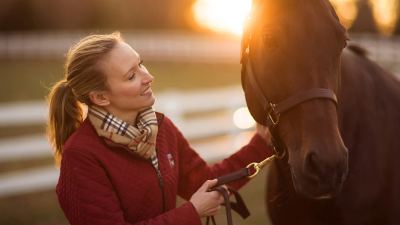Heat and horses: A stressful combination

You'll need to take extra precautions to ensure that your horse stays healthy and safe during particularly warm summer days.
While the northern hemisphere has been experiencing the wrath of the polar vortex and record cold temperatures, the southern hemisphere has been on the opposite end of the spectrum, dealing with sweltering heat. Fortunately, there are generally simple ways for humans to escape the uncomfortable effects of extreme weather — but the same cannot be said for horses, who must expend substantial energy in an effort to keep cool as temperatures rise.
While you can still enjoy equestrian pursuits on relatively warm days, you will want to take extra precautions to ensure that your horse stays healthy and safe in the heat. Equine heat stress is a serious concern, and although it may first manifest in seemingly minor ways, such as poor performance, it can quickly escalate to potentially fatal heat exhaustion and stroke. As such, it is highly important to develop an understanding of the stages and signs of heat stress so that you can take immediate action if you observe them in your horses.
Stage 1:
- The horse may sweat profusely and exhibit a heightened body temperature (the normal equine body temperature ranges from 99–101° Fahrenheit or 37.2–38.3° Celsius).
- The heart rate elevates significantly. A horse’s normal resting heart rate is within 30–50 beats per minute, and a pulse rate of 50 or higher is generally a cause for concern.
- You can also check for signs of dehydration by grasping a fold of skin at the point of the shoulder and releasing it. If the horse is well-hydrated, the skin should snap back quickly (in under one second). Generally, the longer the skin takes to flatten, the more dehydrated the horse. However, it’s important to already know what your horse’s normal skin elasticity is, as this can vary.
- Capillary refill time can also be used to measure hydration. To check this, press lightly on the horse’s gum just above an upper incisor and observe how long it takes for its normal pink color to return; two seconds or less is normal.
Stage 2:
- Rapid, shallow breathing may be apparent. For reference, the normal respiratory rate for a resting adult horse is between eight and 15 breaths per minute.
- The horse’s behavior can become uncooperative; it may frequently kick or randomly shake its head. Minor gait abnormalities may also be observed.
- You may also detect an irregular, fluttery heartbeat or witness tying-up (i.e., muscle cramping as the result of the massive contraction of the muscle groups along the horse’s back and rump).
- Sweating has likely ceased, but the skin remains hot to the touch as body temperature rises. A body temperature between 104–108° Fahrenheit (or 40–42.2° Celsius) indicates a heightened risk of danger for the horse, as heat exhaustion is beginning to set in.
Stage 3:
- The horse will hang its head low and appear extremely unhappy. It may also clearly be struggling to breathe normally, taking slower and deeper breaths, which is known as second-phase panting.
- The pulse will remain heightened but also weak and potentially irregular.
- Gut sounds are reduced or absent.
- The horse may appear confused and make increasingly clumsy movements.
Stage 4:
- The consequences and effects of prolonged heightened body temperature (in excess of 106–108° Fahrenheit, or 41.1–42.2° Celsius) may lead to heat stroke.
- The central nervous system will begin to shut down, which can lead to:
- Severe stumbling or difficulty moving
- Volatile behavior
- Increasingly confused mannerisms
- Collapse
- Convulsions
- Unconsciousness or comatose state
- Death
So, what can you do if your horse appears to be suffering from the ill effects of heat stress?
- Walk the horse out to encourage circulation and to bring heated blood to the surface of the skin for cooling.
- Let the horse drink its fill. A hot horse should take in as much water as it needs to replace what is being sweated out. Cold water is fine — the idea that letting a hot horse drink cold water can cause colic and muscle cramping is simply a myth.
- Splash or spray cold water directly onto the horse to aid with evaporative cooling. Despite what you may have heard, putting cold water on hot muscles does not constrict blood vessels and lead to cramping. Do make sure to frequently scrape off the water, because it will warm up quickly on the horse’s body. Repeat this process until the skin feels cool to the touch and the horse’s breathing appears to have returned to normal.
If the horse’s behavior and drinking habits have not returned to normal within one hour, or if you witness more dramatic signs of heat stress within that window of time, call your veterinarian immediately. Intravenous hydration and other medical measures may be required to prevent potentially irreversible effects or loss of life.















